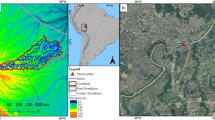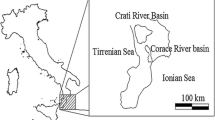Abstract
Rapid and accurate inundation modelling in large floodplains is critical for emergency response and environmental management. This paper describes the development and implementation of a floodplain inundation model that can be used for rapid assessment of inundation in very large floodplains. The model uses high resolution DEM (such as LiDAR DEM) to derive floodplain storages and connectivity between them at different river stages. We tested the performance of the model across several large floodplains in southeast Australia for estimating floodplain inundation extent, volume, and water depth for a few recent flood events. The results are in good agreement with those obtained from high resolution satellite imageries and MIKE 21 two-dimensional hydrodynamic model. The model performed particularly well in the reaches that have confined channels with above 85 % agreement with the flood maps derived from Landsat TM imagery in cell-to-cell comparison. While the model did not performance as well in the flat and complex floodplains, the overall level of agreement of the modelled inundation maps with the satellite flood maps was still satisfactory (60–75 %). The key advantage of this model is demonstrated by its capability to simulate inundation in large floodplains (over 2000 km2) at a very high resolution of 5-m with more than 81 million cells at a reasonably low computational cost. The model is suitable for practical floodplain inundation simulation and scenario modelling under current and future climate conditions.








Similar content being viewed by others
References
Abbott MM (1973) Cubic equations of state. AICHE J 19(3):596–601
Bates PD, De Roo APJ (2000) A simple raster-based model for flood inundation simulation. J Hydrol 236(1–2):54–77
Bates PD, Horritt MS, Smith CN, Mason D (1997) Integrating remote sensing observations of flood hydrology and hydraulic modelling. Hydrol Process 11(14):1777–1795
Bates PD, Horritt MS, Fewtrell TJ (2010) A simple inertial formulation of the shallow water equations for efficient two-dimensional flood inundation modelling. J Hydrol 387(1–2):33–45
Bhuiyan M, Dutta D (2012) Analysis of flood vulnerability and assessment of the impacts in coastal zones of Bangladesh due to potential sea-level rise. Nat Hazards 61(2):729–743
DHI (2012) MIKE 21 - 2D modelling of coast and sea, DHI Water & Environment Pty Ltd., http://www.dhisoftware.com/Products/CoastAndSea/MIKE21.aspx, accessed on 25 August 2012
Di Baldassarre G, Montanari A, Lins H, Koutsoyiannis D, Brandimarte L, Blöschl G (2010) Flood fatalities in Africa: from diagnosis to mitigation. Geophys Res Lett 37(22):L22402
Dottori F, Di Baldassarre G, Todini E (2013) Detailed data is welcome, but with a pinch of salt: accuracy, precision, and uncertainty in flood inundation modeling. Water Resour Res 49(9):6079–6085
Dutta D, Nakayama K (2009) Effects of spatial grid resolution oil river flow and surface inundation simulation by physically based distributed modelling approach. Hydrol Process 23(4):534–545
Dutta D, Herath S, Musiake K (2006) An application of a flood risk analysis system for impact analysis of a flood control plan in a river basin. Hydrol Process 20(6):1365–1384
Dutta D, Alam J, Umeda K, Hayashi M, Hironaka S (2007) A two-dimensional hydrodynamic model for flood inundation simulation: a case study in the lower Mekong river basin. Hydrol Process 21(9):1223–1237
Dutta D, Welsh W, Vaze J, Kim S, Nicholls D (2012) A comparative evaluation of short-term streamflow forecasting using time series analysis and rainfall-runoff models in eWater Source. Water Resour Manag 26(15):4397–4415
Dutta D, Teng J, Vaze J, Lerat J, Hughes J, Marvanek S (2013a) Storage-based approaches to build floodplain inundation modelling capability in river system models for water resources planning and accounting. J Hydrol 504:12–28
Dutta D, Teng J, Vaze J, Hughes J, Lerat J, Marvanek S (2013b) Building flood inundation modelling capability in river system models for water resources planning and accounting, in climate and land surface changes in hydrology, IAHS Red Book. By Boegh E, Blyth E, Hannah DM, Hisdal H, Kunstmann H, Su B, Yilmaz KK (eds) pp. 205–212, IAHS Publication
Gallant JC (2003) A multiresolution index of valley bottom flatness for mapping depositional areas multiresolution valley bottom flatness. Water Resour Res 39(12):1347
Gao BC (1996) NDWI—a normalized difference water index for remote sensing of vegetation liquid water from space. Remote Sens Environ 58(3):257–266
Horritt MS (1999) A statistical active contour model for SAR image segmentation. Image Vis Comput 17(3–4):213–224
Hughes J, Dutta D, Kim S, Vaze J, Podger G (2014) An automated multi-step calibration procedure for a river system model. Environ Model Software 51:173–183
Karim F, Dutta D, Mavanek S, Petheram C, Ticehurst C, Lerat J, Kim S, Yang A (2015) Assessing impacts of climate change and water resources development on floodplains and wetlands in the Flinders and Gilbert Catchments, Australia. J Hydrol 522:80–94
Lhomme J, Sayers P, Gouldby B, Samuels P, Wills M, Mulet-Marti J (2008) Recent development and application of a rapid flood spreading method, in Proceedings of FLOODrisk 2008, Keble College, Oxford, UK, 30 September to 2 October 2008
Nardi F, Vivoni ER, Grimaldi S (2006) Investigating a floodplain scaling relation using a hydrogeomorphic delineation method. Water Resour Res 42(9):W09409
NASA (2012) The thematic mapper, national aeronautics and space administration, http://landsat.gsfc.nasa.gov/about/tm.html, accessed on 03 September 2013
Néelz S (2009) Desktop review of 2D hydraulic modelling packages. Environment Agency, Bristol
Powell SJ, Letcher RA, Croke BFW (2008) Modelling floodplain inundation for environmental flows: Gwydir wetlands, Australia. Ecol Model 211(3–4):350–362
Priestnall G, Jaafar J, Duncan A (2000) Extracting urban features from LiDAR digital surface models. Comput Environ Urban Syst 24(2):65–78
Pulvirenti L, Chini M, Pierdicca N, Guerriero L, Ferrazzoli P (2011) Flood monitoring using multi-temporal COSMO-SkyMed data: image segmentation and signature interpretation. Remote Sens Environ 115(4):990–1002
Smith LC (1997) Satellite remote sensing of river inundation area, stage, and discharge: a review. Hydrol Process 11(10):1427–1439
Teng J, Vaze J, Tuteja NK, Gallant JC (2008) A GIS-based tool for spatial and distributed hydrological modelling: CLASS spatial analyst. Trans GIS 12(2):209–225
Teng J, Vaze J, Dutta D (2013) Simplified methodology for floodplain inundation modelling using LiDAR DEM, in Climate and land surface changes in hydrology, IAHS Red Book, by Boegh E, Blyth E, Hannah DM, Hisdal H, Kunstmann H, Su B, Yilmaz KK (eds) pp. 198–204, IAHS Publication
Thompson JR, Sorenson HR, Gavin H, Refsgaard A (2004) Application of the coupled MIKE SHE/MIKE 11 modelling system to a lowland wet grassland in southeast England. J Hydrol 293(1–4):151–179
Tsakiris G, Bellos V (2014) A numerical model for two-dimensional flood routing in complex terrains. Water Resour Manag 28(5):1277–1291
Vaze J, Teng J, Spencer G (2010) Impact of DEM accuracy and resolution on topographic indices. Environ Model Software 25(10):1086–1098
Vaze J, Davidson A, Teng J, Podger G (2011) Impact of climate change on water availability in the Macquarie-Castlereagh River Basin in Australia. Hydrol Process 25(16):2597–2612
Vaze J et al (2013) The Australian Water Resource Assessment System (AWRA). In Proceedings of the 20th International Congress on Modelling and Simulation (MODSIM2013), edited, Adelaide, Australia
Welsh WD et al (2013) An integrated modelling framework for regulated river systems. Environ Model Software 39:81–102
Williams WA (2000) An automated technique for delineating and characterizing valley-bottom settings. Environ Monit Assess 64(1):105–114
Compliance with Ethical Standards
Funding
This study was undertaken as part of the Australian Water resource Assessment (AWRA) project and was funded by the Land and Water Flagship, CSIRO and the Australian Bureau of Meteorology (BoM) under the WIRADA alliance between CSIRO and BoM.
Conflict of Interest
The authors declare that they have no conflict of interest.
Author information
Authors and Affiliations
Corresponding author
Rights and permissions
About this article
Cite this article
Teng, J., Vaze, J., Dutta, D. et al. Rapid Inundation Modelling in Large Floodplains Using LiDAR DEM. Water Resour Manage 29, 2619–2636 (2015). https://doi.org/10.1007/s11269-015-0960-8
Received:
Accepted:
Published:
Issue Date:
DOI: https://doi.org/10.1007/s11269-015-0960-8




